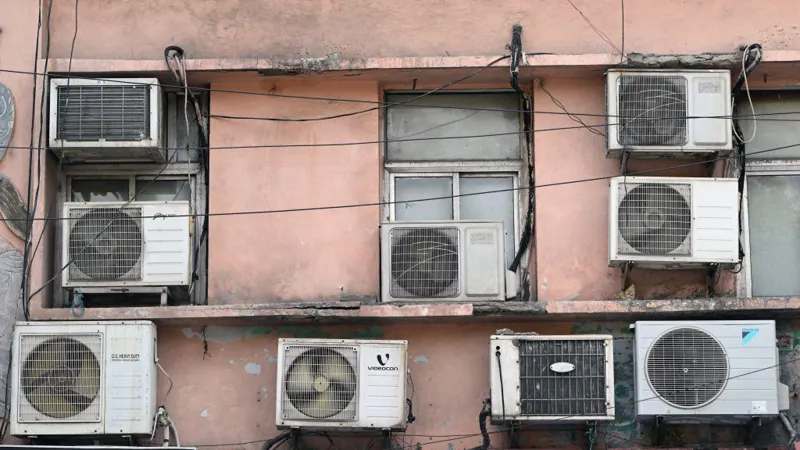Getty Images: Air conditioning units hang from a building during high temperatures in New Delhi, India, on Thursday, May 30, 2024. [ India is the world’s fastest-growing market for air conditioners]
In the blistering heat of Delhi, Govind Ram, a scrap dealer residing on the outskirts of the city, capitulated to his children’s pleas and purchased an air conditioner in May. The oppressive heatwave had rendered the city a veritable furnace, causing his school-aged children to suffer from the sweltering conditions. Although this purchase has provided much-needed relief, it came with a steep price—his electricity bill skyrocketed to seven times its usual amount.
Ram reflected, “I’ve weathered the most torrid summers with just a fan. But this year, my children’s discomfort compelled me to buy our family’s first air conditioner.”
Over the past fifty years, India has endured over 700 heatwaves, but experts contend that this summer’s relentless heat is among the most severe. While 97% of Indian households have electricity, with 93% relying on fans, the market for air conditioners has seen unprecedented growth this year, according to the Council on Energy, Environment, and Water (CEEW).
“In my 45 years in the air-con industry, I’ve never witnessed anything like this. The surge in demand is astonishing, with sales expected to more than double this summer compared to last year,” said B Thiagarajan, managing director of Blue Star, a leading cooling and refrigeration company.
Nearly a billion people across 23 states in India are currently exposed to heat stress. Thiagarajan predicts a remarkable 60% growth in air conditioner sales this summer—March to July—compared to the usual 25-30% growth seen in previous years. He recalled a time when sales peaked in the last week of May, but now, demand surges in April. Companies have sold in three months what they typically sell in nine.
Despite only 8% of India’s 300 million households owning air conditioners, India is the fastest-growing market for ACs globally. Of the 170 million units sold worldwide last year, China purchased 90 million, while India bought 12 million. The International Energy Agency (IEA) forecasts a nine-fold increase in home air conditioner ownership in India by 2050, surpassing the growth of all other household appliances.
By mid-century, India’s electricity demand from home air conditioners will exceed Africa’s current total electricity consumption, according to the IEA. This trend reflects the rising aspirations, disposable incomes, and extreme weather conditions.
Most Indian air-con buyers are middle-class first-time purchasers, with 65% from smaller cities and towns. Over half of these buyers use zero-interest consumer loans, and the average buyer is now in their thirties. The majority of sales come from the hotter northern region, where daily temperatures in Delhi have consistently exceeded 40°C (104°F) since mid-May.
Experts attribute the increased heat in Indian cities to unbalanced development. According to CEEW, nearly a billion people in 23 states face heat stress. The lack of green spaces, the encroachment of water bodies, and rising greenhouse gas emissions exacerbate urban heat. The proliferation of poorly ventilated high-rise apartments and glass-clad office buildings further intensifies the heat.
A survey by Artha Global’s Centre for Rapid Insights (CRI) revealed that 32% of respondents find their homes hot and uncomfortable in the afternoon. Among those with cooling solutions, 42% use energy-intensive air conditioners or coolers, highlighting the costliness of managing heat.
Data shows that the disparity between rich households, who own air conditioners, and poor households, who cannot afford them, is widening. Slum dwellers, living in poorly ventilated, windowless shanties with unreliable electricity, find staying indoors unbearable. Many work in luxury apartments with 24/7 electricity and air conditioning, underscoring the stark contrast in living conditions.
India must rejuvenate its aquatic habitats and build cooler houses with innovative solutions like white-painted roofs and chilled water pipelines. Additionally, adopting more energy-efficient air conditioners is crucial.
Last year, 63 countries signed a pledge to reduce cooling emissions significantly. While India did not sign, it has made progress with policies to improve AC energy efficiency. Inverter ACs now dominate the market, and energy ratings for fans are mandatory.
Despite these efforts, a LocalCircles survey found that 43% of air-con users in Delhi and its suburbs report that their units cannot cool to the 23-24°C range. With temperatures often above 45°C, air conditioning has become a necessity.
However, widespread use of air conditioners raises outdoor temperatures and poses environmental risks due to chemical refrigerants. As extreme weather events become more frequent and intense, India must do more to protect its population from heat. Over 140 people have died from extreme heat this summer, with the true number likely much higher.
The surge in air conditioner sales amid India’s heatwave underscores the urgent need for equitable access to cooling solutions, highlighting the pressing challenges in adapting to a changing climate.
#Heatwave2024 #ClimateChange #IndiaACMarket #EnergyEfficiency #UrbanHeat
